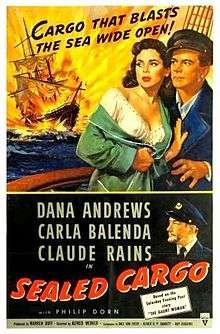Sealed Cargo
| Sealed Cargo | |
|---|---|
 | |
| Directed by | Alfred L. Werker |
| Produced by |
Warren Duff Samuel Bischoff |
| Written by |
Edmund Gilligan (novel) Dale Van Every Oliver H. P. Garrett Roy Huggins |
| Starring |
Dana Andrews Carla Balenda Claude Rains |
| Music by | Roy Webb |
| Cinematography | George E. Diskant |
| Edited by | Ralph Dawson |
Production company | |
| Distributed by | RKO Radio Pictures |
Release dates |
|
Running time | 87-90 minutes |
| Country | United States |
| Language | English |
Sealed Cargo is a 1951 American war film about a fisherman, played by Dana Andrews, who gets tangled up with Nazis and their U-boats. It was based on the novel The Gaunt Woman by Edmund Gilligan.
Plot
In 1943, at the height of the World War II Battle of the Atlantic, Captain Pat Bannon, skipper of the fishing trawler Daniel Webster, unloads his catch in his home port of Gloucester, Massachusetts. He reluctantly agrees to transport Margaret McLean to Trabo, a small community in Newfoundland. Shorthanded, he hires Danish sailor Konrad, and the Daniel Webster sails for the Grand Banks fishing grounds. Once at sea, another Dane, Holger, reports that the radio has been sabotaged. As Bannon knows all of the crew well except for Konrad and fellow Dane Holger, he suspects one of them or even Margaret of being a German agent.
Sailing at night in heavy fog, they hear gunfire. They search for survivors and come upon the damaged Den Magre Kvinde (Danish for The Gaunt Woman), a Danish square rigged sailing ship. She appears to have been damaged in a storm and then shelled. Aboard, they discover only the dazed Captain Skalder and a dead body. He claims that his crew abandoned ship in a storm, and that he was subsequently attacked by a U-boat. The Daniel Webster tows the stricken Kvinde to Trabo.
Konrad is suspicious: he notes that the German gunfire hit above the waterline (rather than below it, where a gunner intending to sink a ship would aim), and that while the tarpaulin covering the ship's boat is riddled with bullet holes, the boat itself is undamaged. Bannon and Konrad separately sneak below decks to search the hold. When they meet, Konrad has a pistol, but he gives it to Bannon to prove where his loyalties lie. They accidentally discover a second, hidden hold containing rack upon rack of torpedoes — the ship is a tender, covertly resupplying the U-boat "wolfpacks". They watch undetected as Holger enters the hold and uses a radio to signal the Germans. However, before the pair can alert the military, Skalder's crew arrives in boats, so they pretend they know nothing. Skalder plans to resupply the U-boats at Trabo.
A Canadian flying boat lands in the harbor, and an officer inspects Skalder's papers. Finding nothing wrong, he informs Skalder that a corvette will arrive the next day to inspect his cargo. Bannon offers to leave one of his two Danish crewman as a witness, allowing him to rid himself of the spy Holger without arousing suspicion.
Bannon leaves port, but once out of sight, one man remains aboard to sail to the nearest radio station, while Bannon and the rest take to the dories and return. Bannon sets up a night ambush; when the Germans come to take the villagers prisoner, the invaders are wiped out. Bannon and his men then set fire to the Kvinde under cover of darkness. In the resulting confusion, they board, overpower or kill the remainder of the crew, and free Margaret, who had been taken as a hostage.
Skalder claims to have set the ship to blow up in twenty minutes. Bannon does not believe him, but takes the ship out to sea, intending to destroy her safely away from the village. He and his men rig some of the torpedoes to explode. The Kvinde is approached by two U-boats seeking supplies. Skalder manages to get a gun and wounds his guard, Konrad, before he is killed. As a third U-boat surfaces, Bannon helps Konrad into a boat and flees under German gunfire. When the ship explodes, the resulting wave swamps the submarines, sinking them.
Cast
- Dana Andrews as Pat Bannon
- Carla Balenda as Margaret McLean
- Claude Rains as Captain Skalder
- Philip Dorn as Konrad
- Onslow Stevens as Commander James McLean, Margaret's father
- Skip Homeier as Steve
- Eric Feldary as Holger
- J. M. Kerrigan as Skipper Ben
- Arthur Shields as Kevin Dolan
- Morgan Farley as Caleb
References
- ↑ "Sealed Cargo: Detail View". American Film Institute. Retrieved May 19, 2014.
External links
- Sealed Cargo at the Internet Movie Database
- Sealed Cargo at the TCM Movie Database
- Sealed Cargo at AllMovie